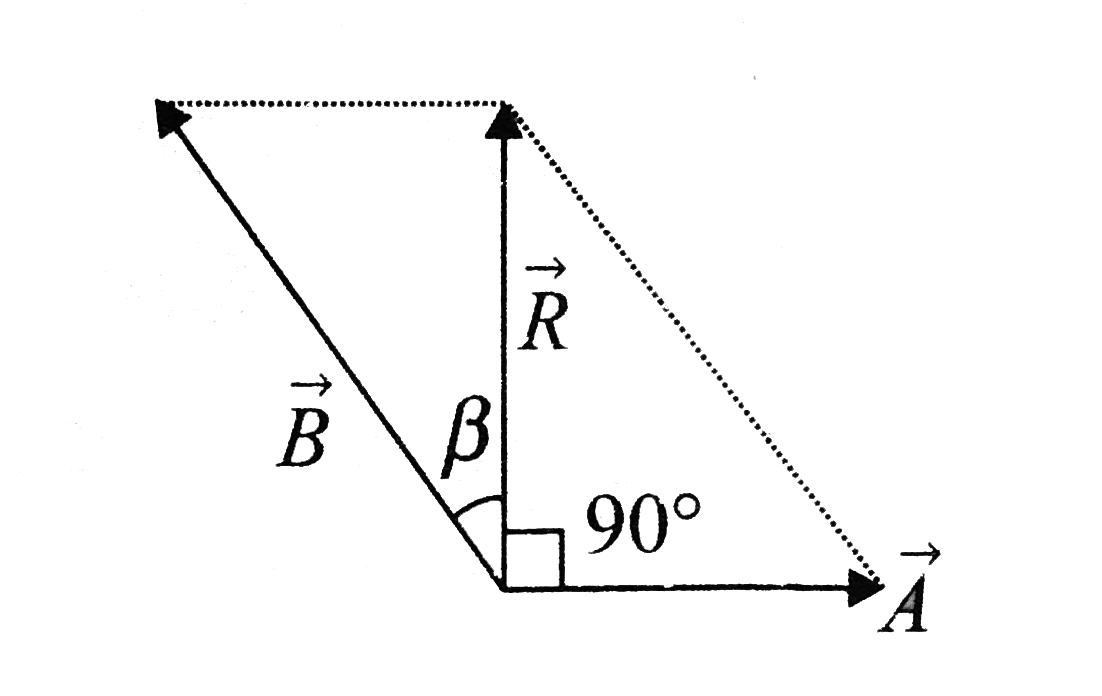What is the condition for magnitude of →A+→B to be equal to that of →A−→B ?
To find the condition for the magnitudes of the vectors →A+→B and →A−→B to be equal, we can follow these steps:
Step 1: Set up the equation
We start with the condition given in the problem:
|→A+→B|=|→A−→B|
Step 2: Write the expressions for the magnitudes
Using the formula for the magnitude of a vector, we can express the magnitudes as:
|→A+→B|=√|→A|2+|→B|2+2|→A||→B|cosθ
|→A−→B|=√|→A|2+|→B|2−2|→A||→B|cosθ
Step 3: Set the two expressions equal to each other
Now we equate the two magnitudes:
√|→A|2+|→B|2+2|→A||→B|cosθ=√|→A|2+|→B|2−2|→A||→B|cosθ
Step 4: Square both sides to eliminate the square roots
Squaring both sides gives us:
|→A|2+|→B|2+2|→A||→B|cosθ=|→A|2+|→B|2−2|→A||→B|cosθ
Step 5: Simplify the equation
We can cancel |→A|2+|→B|2 from both sides:
2|→A||→B|cosθ=−2|→A||→B|cosθ
Step 6: Combine like terms
Adding 2|→A||→B|cosθ to both sides results in:
4|→A||→B|cosθ=0
Step 7: Solve for cosθ
From this equation, we can see that:
cosθ=0
Step 8: Determine the angle
The condition cosθ=0 implies that:
θ=π2
This means that the vectors →A and →B are perpendicular to each other.
Conclusion
The condition for the magnitudes of →A+→B and →A−→B to be equal is that the vectors →A and →B are perpendicular.
---
We start with the condition given in the problem:
|→A+→B|=|→A−→B|
Using the formula for the magnitude of a vector, we can express the magnitudes as:
|→A+→B|=√|→A|2+|→B|2+2|→A||→B|cosθ
|→A−→B|=√|→A|2+|→B|2−2|→A||→B|cosθ
Now we equate the two magnitudes:
√|→A|2+|→B|2+2|→A||→B|cosθ=√|→A|2+|→B|2−2|→A||→B|cosθ
Squaring both sides gives us:
|→A|2+|→B|2+2|→A||→B|cosθ=|→A|2+|→B|2−2|→A||→B|cosθ
We can cancel |→A|2+|→B|2 from both sides:
2|→A||→B|cosθ=−2|→A||→B|cosθ
Adding 2|→A||→B|cosθ to both sides results in:
4|→A||→B|cosθ=0
From this equation, we can see that:
cosθ=0
The condition cosθ=0 implies that:
θ=π2
This means that the vectors →A and →B are perpendicular to each other.
The condition for the magnitudes of →A+→B and →A−→B to be equal is that the vectors →A and →B are perpendicular.
Topper's Solved these Questions
- BOOK - ICSECHAPTER - VECTORS SCALARS ELEMENTARY CALCULUS EXERCISE - VERY SHORT ANSWER QUESTIONS10videos
VECTORS SCALARS ELEMENTARY CALCULUS
- BOOK - ICSECHAPTER - VECTORS SCALARS ELEMENTARY CALCULUS EXERCISE - SELECTED PROBLEMS (FROM VECTOR ADDITION )14videos
VECTORS SCALARS ELEMENTARY CALCULUS
- BOOK - ICSECHAPTER - VECTORS SCALARS ELEMENTARY CALCULUS EXERCISE - LONG ANSWER QUESTIONS5videos
VECTORS SCALARS ELEMENTARY CALCULUS
- BOOK - ICSECHAPTER - UNITSEXERCISE - MODULE 3 (SELECTED PROBLEMS)38videos
UNITS
- BOOK - ICSECHAPTER - WAVESEXERCISE - From Musical Sound10videos
WAVES
Similar Questions
Two vectors →A and →B have equal magnitudes . If magnitude of →A+→B is equal to n× the magnitude of →A−→B , then the angle between →A and →B is
View Solution→A×→B not equal to →B×→A . Why?
View Solution→Aand→B are two vectors having the same magnitude . What is the condition that (i) the vector sum →A+→B and (ii) the vector differece →A+→B have the same magnitude as →Aand→B ?
View SolutionShow that the magnitude of vector sum of →aand→b cannot be greater than |→a|+∣∣→b∣∣ or smaller than |→a|−∣∣→b∣∣
View Solution→Aand→B are two vectors such that →A is 2 m long and is 60∘ above the x - axis in the first quadrant →B is 2 m long and is 60∘ below the x - axis in the fourth quadrant .
Draw diagram to show →a+→B,→A−→Band→B−→A
(b) What is the magnitude and direction of →A+→B,→A−→Band→B−→AView SolutionWhat is the value of (→A+→B).(→A×→B) ?
View SolutionThe resultant of two vectors →A and →B is perpendicular to the vector →A and its magnitudes is equal to half of the magnitudes of vector →B (figure). The angle between →A and →B is
 View Solution
View Solutiona, b are the magnitudes of vectors →a & →b. If →a×→b=0 the value of →a.→b is
View SolutionIf →A=→B+→C, and the magnitudes of →A,→B,→C are 5,4, and 3 units, then the angle between →A and →C is
View SolutionThree vectors →a, →b, →c satisfy the condition →a+→b+→c=→0 . Evaluate the quantity μ=→a.→b+→b.→c+→⋅→a, if |→a|=1, ∣∣→b∣∣=4 and |→c|=2.
View Solution

